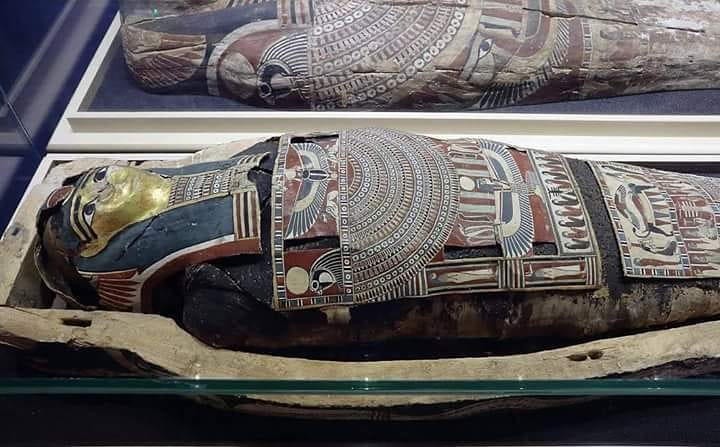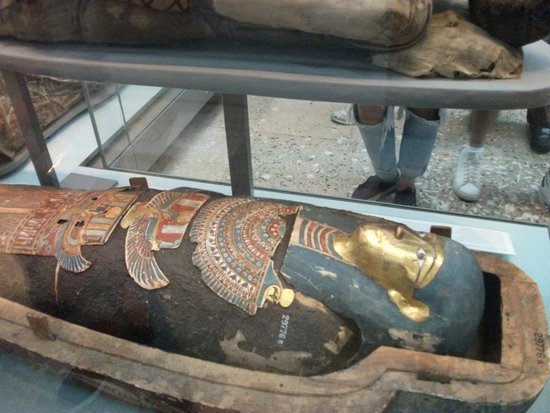Introduction: A Window into the Past
The Lady Mummy and her outer case, dated around 250 BC, are among the treasures of the Durham Oriental Museum. Likely originating from Akhmim, Upper Egypt, these artifacts provide invaluable insights into the lives, health, and spiritual beliefs of ancient Egyptians. Though over 2,000 years old, the combination of artistic craftsmanship and scientific investigation helps us piece together her story, blending art, culture, and medicine.
The Coffin: A Tale of Two Crafts
The Outer Case
The outer coffin, designed to house and protect the mummy, presents a curious mix of artistry and imperfection. While the body of the coffin is adorned with intricate, skillfully painted designs, the head appears rushed and crudely modeled. This disparity raises questions:
- Was the hurried carving a result of time constraints, limited resources, or differing craftsmen involved in the process?
- Could it reflect social or economic status, where resources might have been allocated more toward the mummy than the outer case?
Despite these imperfections, the coffin’s painted motifs remain vivid, likely intended to guide the deceased into the afterlife. These designs often symbolized protection and transformation, highlighting ancient Egyptians’ deep spirituality.

The Mummy: A Life of Struggles and Rituals of Hope
Health in Ancient Egypt
The mummy of this woman tells a poignant story of hardship. Modern X-ray analysis reveals that she endured several health issues during her life:
- Congenital birth defect: A withered left arm, likely resulting from a developmental abnormality.
- Malnutrition in infancy: Indicative of food scarcity or illness during her early years.
- Degenerative conditions: Evidence of a slipped disc and kidney stones, conditions that would have caused significant pain.
- Dental health: Severe abscesses suggest a diet high in coarse grains and sugar-rich foods, common in ancient Egyptian diets.
These ailments reflect the challenges of daily life in ancient Egypt, even for individuals who could afford mummification.
Rituals and Symbolism – The False Arm
One of the most intriguing discoveries is the false arm buried with her. Ancient Egyptians believed that the physical body’s condition directly impacted the deceased’s ability to function in the afterlife. This artificial arm, likely crafted with great care, symbolized completeness and was meant to restore her body’s integrity in eternity.
This practice highlights the compassionate and spiritual approach of ancient Egyptian mortuary customs. It also suggests a societal acknowledgment of physical disabilities and efforts to address them in both life and death.

Analysis: Cultural and Historical Implications
Social Status and Mummification
The disparity between the coffin’s craftsmanship and the mummy’s preservation suggests the deceased might have belonged to a modestly wealthy family. While they could afford mummification, the rushed quality of the coffin’s head might reflect financial or time limitations.
Medicine and Diet in Ancient Egypt
The health conditions observed in this mummy provide a snapshot of the medical knowledge and dietary practices of the time. Limited access to medical treatments and a diet heavy in bread and beer, staples of ancient Egypt, likely contributed to her ailments.
Afterlife Beliefs and Disabilities
The inclusion of the false arm underscores the Egyptians’ unwavering faith in the afterlife and their determination to prepare the deceased for it. This artifact shows how disabilities were viewed with empathy, and measures were taken to ensure spiritual wholeness.

Conclusion: A Legacy of Resilience and Belief
The Lady Mummy and her case offer a multifaceted glimpse into ancient Egypt—its artistry, health challenges, and enduring spiritual traditions. Through scientific analysis and cultural interpretation, this artifact connects us to a woman who, despite her struggles, was honored with the hope of a complete and harmonious afterlife.
This blend of ancient craftsmanship and modern technology allows us to continue unraveling the mysteries of a civilization that deeply valued life and the promise of eternity.
